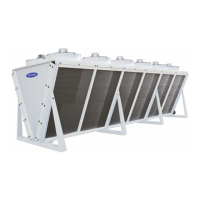13 - MAINTENANCE
13.1 - Recommendations for maintenance
■ Make sure power to the unit has been disconnected before servicing.
■ Reduce the temperature and pressure before carrying out any work on the bundle.
■ Do not make any modications without our agreement.
■ Do not walk directly on the unit.
■ Depending on the type of uid (e.g. water without anti-freeze), take precautions to prevent the risk of freezing, which would destroy
the coil. As standard units cannot be completely drained by gravity, protect from freezing as follows:
1. Drain the circuit using the bleed nozzles and the vent located on the manifolds or pipes.
2. Circulate compressed air through the circuit until all water has been removed.
3. Fill the circuit with anti-freeze and close the circuit.
■ For regulated units, do not forget the mandatory inspections.
■ In winter, do not allow snow to accumulate around and on top of the unit.
■ Periodically check the condition of the coatings and apply touch-ups as needed.
13.2 - Maintenance frequency
ACTION FREQUENCY
Retighten nuts and bolts on fan motor assemblies (grille, motor). 6 months
Check and, if necessary, retighten the packing boxes and the terminal box mounting bolts 6 months
Clean the coil. 1 year (1)
Retighten the electrical connections.
1 month after system start-up then 1
year
Retighten all visible nuts and bolts. 1 year
Check for corrosion to the panelling and that the safety labels and name plate label are present. 1 year (1)
Clean the louvres on the electrical cabinet (optional) 1 year
Check the electrical cables. 5 years
(1) Frequency to be adapted to the environmental conditions.
13.3 - Cleaning the coils
■ Switch off the unit.
■ If the unit is tted with a "protective screen" option, remove this to access the coils.
■ If the ns are damaged, straighten them using a comb.
■ In the event of minor fouling (non-clogging dry residue or dust, leaves, wires, etc.):
- Counter-ow supply air: dry air up to 30 bar.
- Where possible, periodically reversing the ow of air generated by the fans can prevent this. This operation is not possible if the
unit is equipped with EC motors.
■ In the event of moderate fouling (moderate clogging due to dry residues, damp dust or grass, insects, etc.):
- Use a high-pressure (HP) steam cleaner with a at jet nozzle (25°).
- Max. pressure 100 bar
- Steam: max. 140°C
- Min. distance between the nozzle and the ns = 200 mm
- Cleaning uid: municipal water with pH neutral detergent (pH 7). Avoid alkaline detergents.
- Flushing with clean water using the same adjustment parameters.
■ IMPORTANT: the use of detergent is prohibited for cleaning ns with a BLYGOLD
®
, ALTENA
®
or HERESITE
®
coating.
Recommendations to follow when using a HP cleaner
1. Wait for the HP cleaner to fully warm up. Check that the uid exiting the nozzle is steam
rather than liquid.
2. Hold the high-pressure cleaner's lance at a distance greater than that recommended,
then move forward into the working position.
3. Direct the at jet created by the nozzle onto the surface of the ns and perpendicular to
them. An angled position risks pushing the ns together and a parallel position risks
pushing them apart.
4. To prevent residue from being pushed inside the nned block, it is often useful to perform
an initial wash against the air ow direction (at the discretion of the operator and depending
on the fouling level).
5. Some detergents may damage the unit's paintwork.
NO
NO
YES
14

